
CHYBIK + KRISTOF ARCHITECTS & URBAN DESIGNERS在捷克共和国的 Lahofer Winery已经完成了建设。位于摩拉维亚乡下的 Lahofer Winery酒厂融合了该地区悠久的葡萄酒传统和与周围葡萄树对话的现代设计。这座体现现代酿酒工艺的建筑,将三个相互联系的建筑组合在一起:酿酒设施,酒厂的管理基地,游客中心和毗邻的品酒室。仿效当地典型的酒窖,酒厂的拱顶是由拱梁构成的网状结构。镜子形状的屋顶作为一个开放的文化活动空间,对当地人和游客开放,使酒店与当地的环境和文化相融合。
CHYBIK + KRISTOF ARCHITECTS & URBAN DESIGNERS have completed construction of the Lahofer Winery in the Czech Republic. Nestled in the Moravian countryside, the Lahofer Winery fuses the region’s longstanding wine tradition with a contemporary design in constant dialogue with the surrounding vines. Reflective of modern wine-making processes, the building brings together three distinct interconnected structures – a wine-making facility, the winery’s administrative base, and a visitor center and adjoining tasting room. Emulating archetypal wine cellars of the region, the vault of the winery rests on a grid of arched beams. Acting as a mirror of this shape, an undulant roof serves as an amphitheater for cultural events open to both locals and visitors, merging the winery into the ground – and the culture – on which it rests.
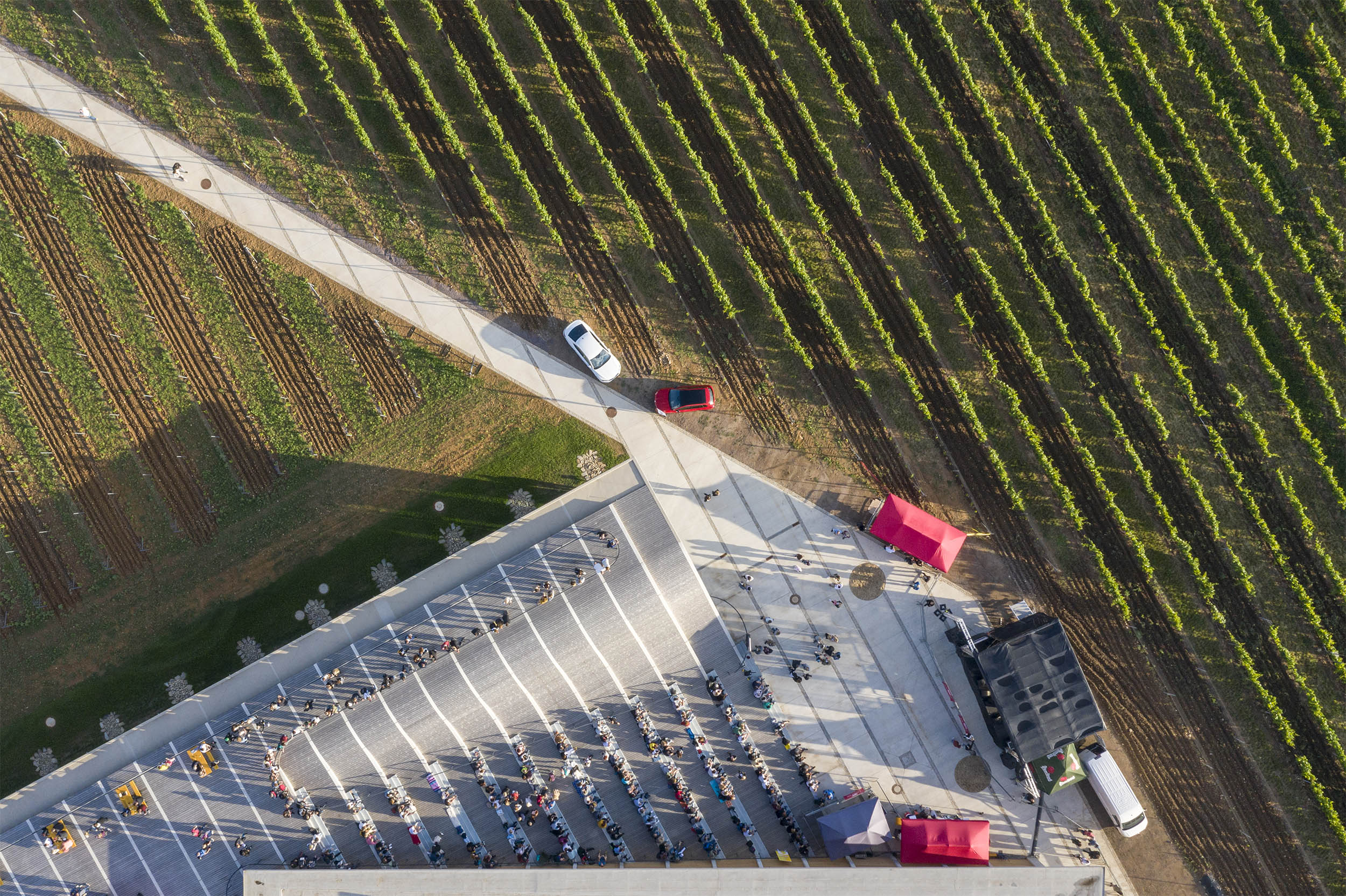

CHYBIK + KRISTOF的项目源自Lahofer Winery酒厂的传统,这是建立在对自然环境深切尊重的历史文化遗产之上的。作为对摩拉维亚地形和植根于葡萄酒文化的建筑传统的回应,建筑师构思了一种与当地景观共生的设计方案。横梁和柱廊使人联想到该地区独特的拱形酒窖,使室内空间构架成层叠式曲线。室外,波浪起伏的屋顶覆盖着酒庄,是一个倾斜的露天剧院和文化场所。建筑物位于肥沃的土壤上,体量很小,下面是三个独立的空间,每一个都有不同的功能,分享着对相邻自然的持续关注。
CHYBIK + KRISTOF’s project finds its roots in the legacy of the Lahofer Winery – one grounded in a storied cultural heritage and a profound respect for the natural environment. Responding to Moravia’s topography and architectural tradition, rooted in the culture of wine, the architects conceive a design in symbiosis with the region’s landscape. Reminiscent of the region’s characteristic arched wine cellars, a colonnade of vaulted beams frames the interior space into its storied curve. On its exterior side, draping the winery, an undulant roof acts as an inclined open-air amphitheater and cultural venue. Lightening the volume of the building as it rests on the fertile soil, below lie three separate spaces – each attributed with a distinct function, they share a constant concern for the adjoining nature.
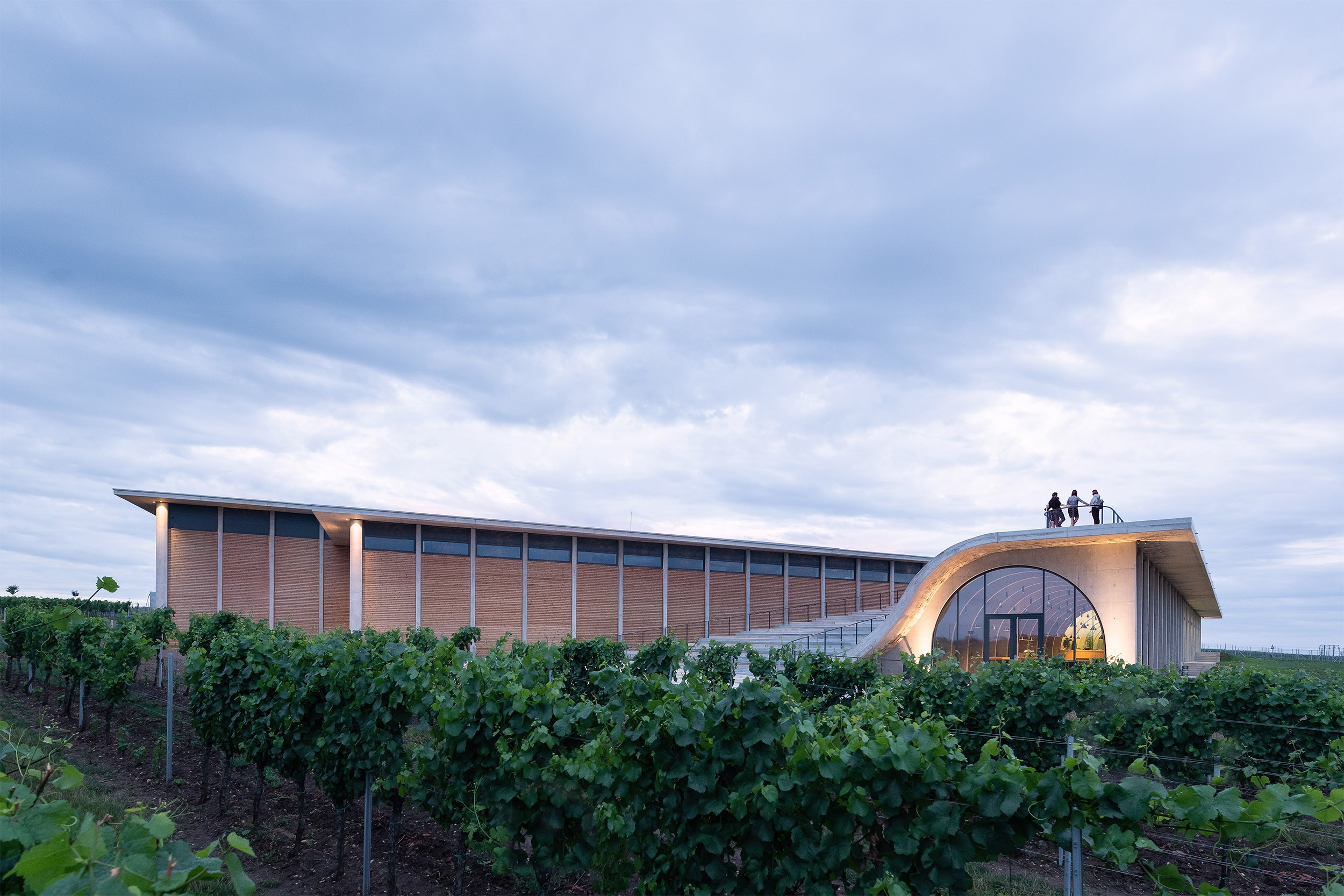


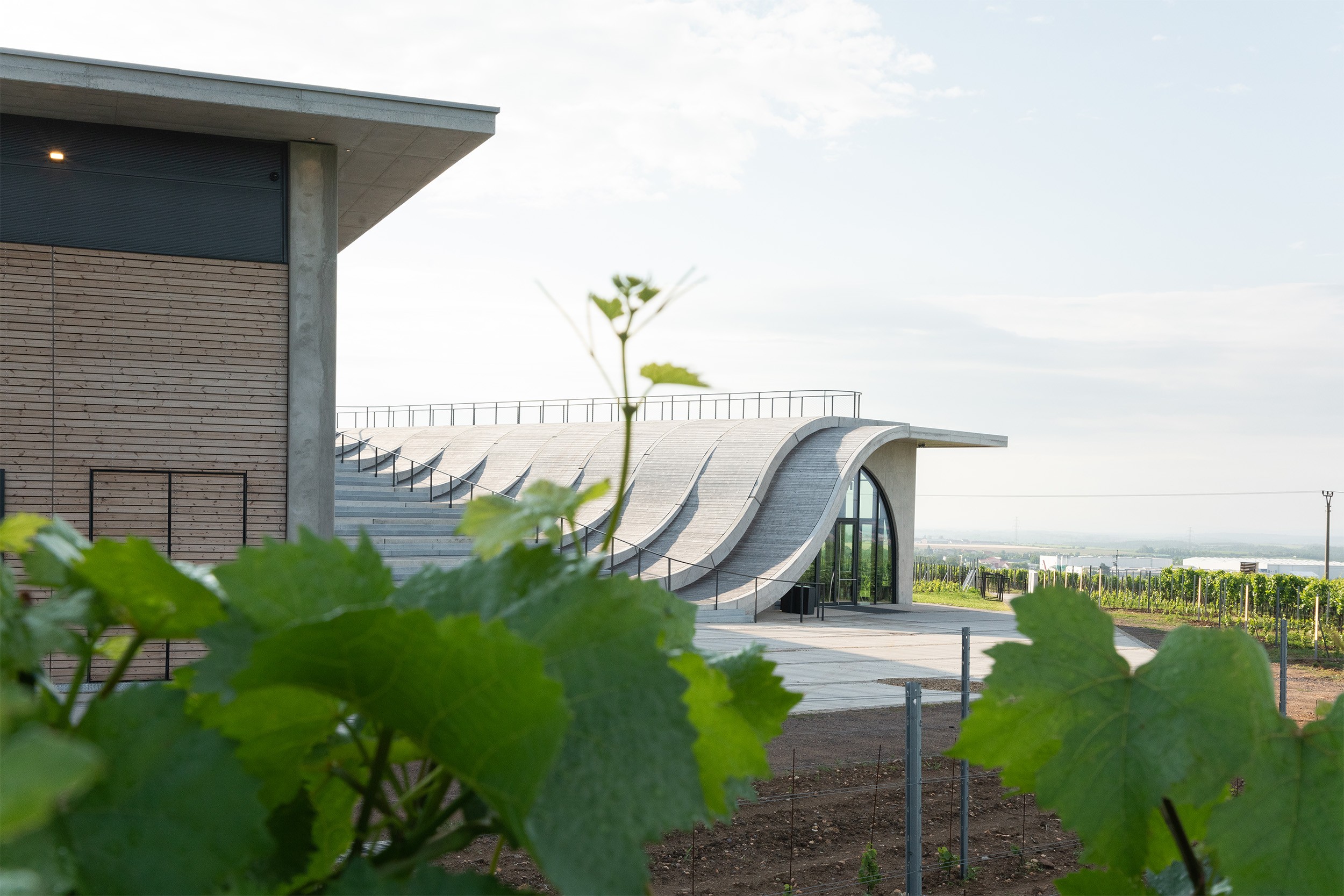
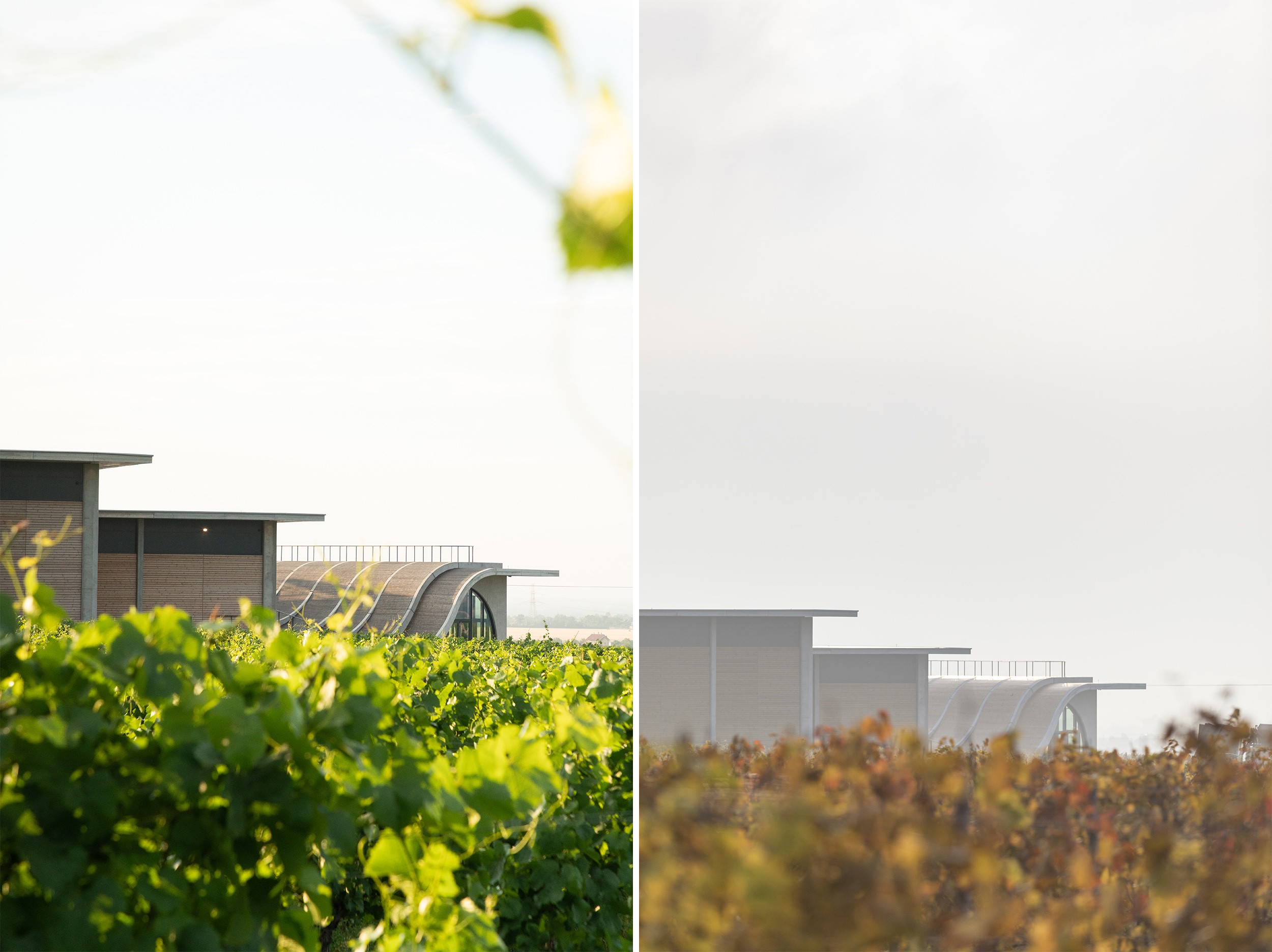
在凹凸的屋顶广场下面,展开了一个巨大的地下室空间,通过拱门的外露肋骨结构,体现了捷克葡萄酒厂的典型设计。每一个钢筋混凝土拱形都是根据天花板的特定角度单独设计的,而拱形间的距离则取决于葡萄树的行距。每个模块从葡萄树行间升起并贯穿整个空间,实现了完美的视觉对称,并引导观赏者的目光穿过葡萄树。观光客中心被玻璃幕墙包围,朝向南方,由于窗户和外面的葡萄树行进的隐蔽隔开,吸引了大量的光线。参观者中心受到自然环境的影响,让参观者在由木材、混凝土和玻璃制成的酒窖及邻近的品酒室中充分体验产品。捷克当代艺术家Patrik Hábl在天花板上画了大量壁画。从土红、黑色到风土褐色、米色,它的笔触是变化多端、不规则稀疏的,与土壤的变化和失重的感觉相呼应,仿佛是从地面升起,在墙上留下了永恒的印记。
Towered by the concave roof of the amphitheater, the space unfolds into a vast cellar, embracing the design of archetypal Czech wineries defined by the exposed rib construction of the arches. Each reinforced concrete arch is individually designed to fit a specific angle of the ceiling, while the distance between the arches is determined by that between the vine rows. Each module rises from a vine row and runs through the space, achieving perfect visual symmetry and guiding the viewer’s gaze across the grapevines. Enclosed in a glass façade and facing south, the visitor center draws abundant light as the windows act as concealed separation from the exterior vine rows. Informed by the ambient nature, the visitor center invites visitors to fully experience its produce in the barrique cellar, made of wood, concrete and glass, and adjoining tasting room. A large-scale mural painting by Czech contemporary artist Patrik Hábl covers the entire ceiling area. Its tampered, irregular and sparse strokes, ranging from earthy reds and blacks to terroir-reminiscent browns and beiges, echo the variations of the soil and its weightlessness as it seemingly lifts from the ground, leaving its timeless markings on the walls.
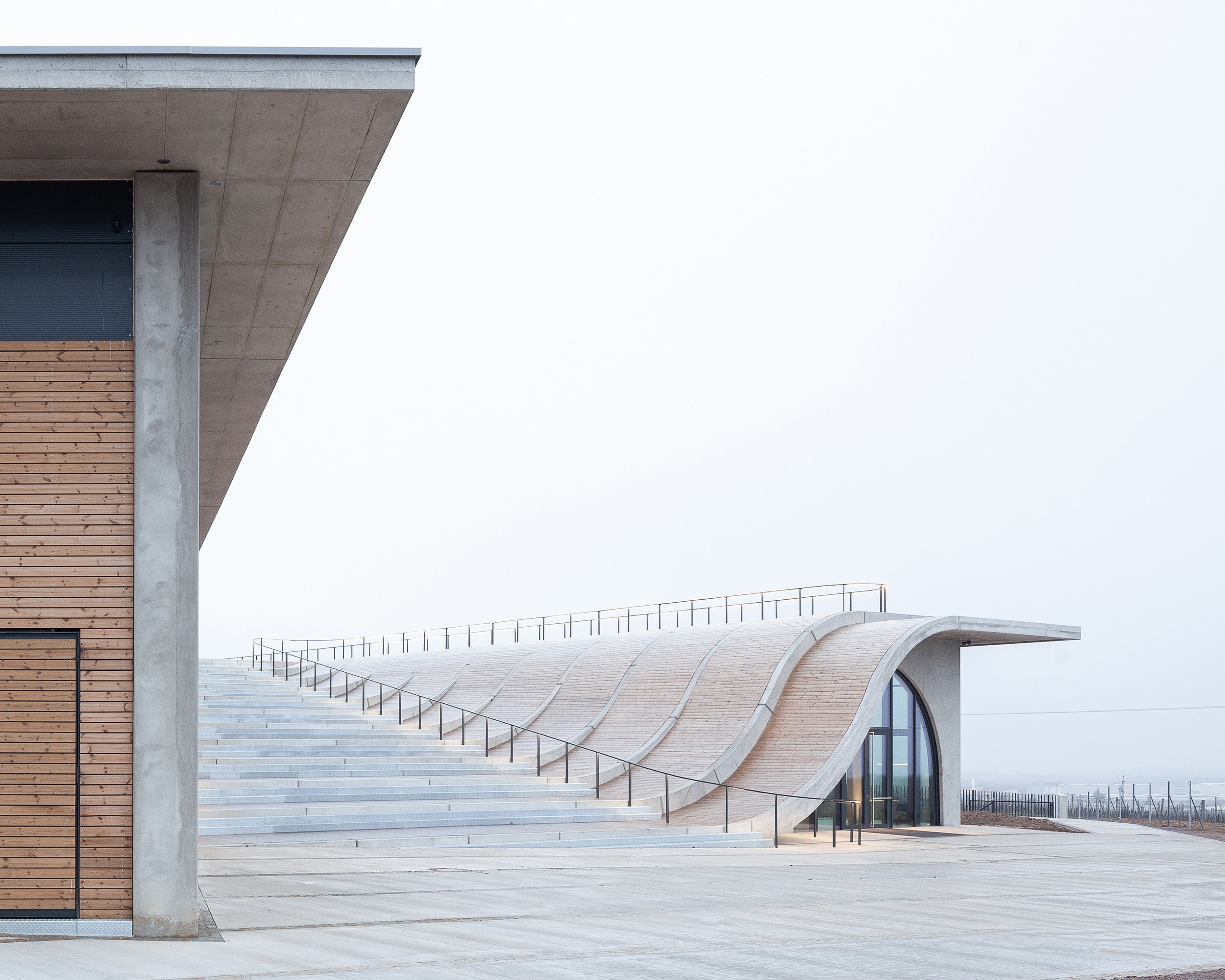
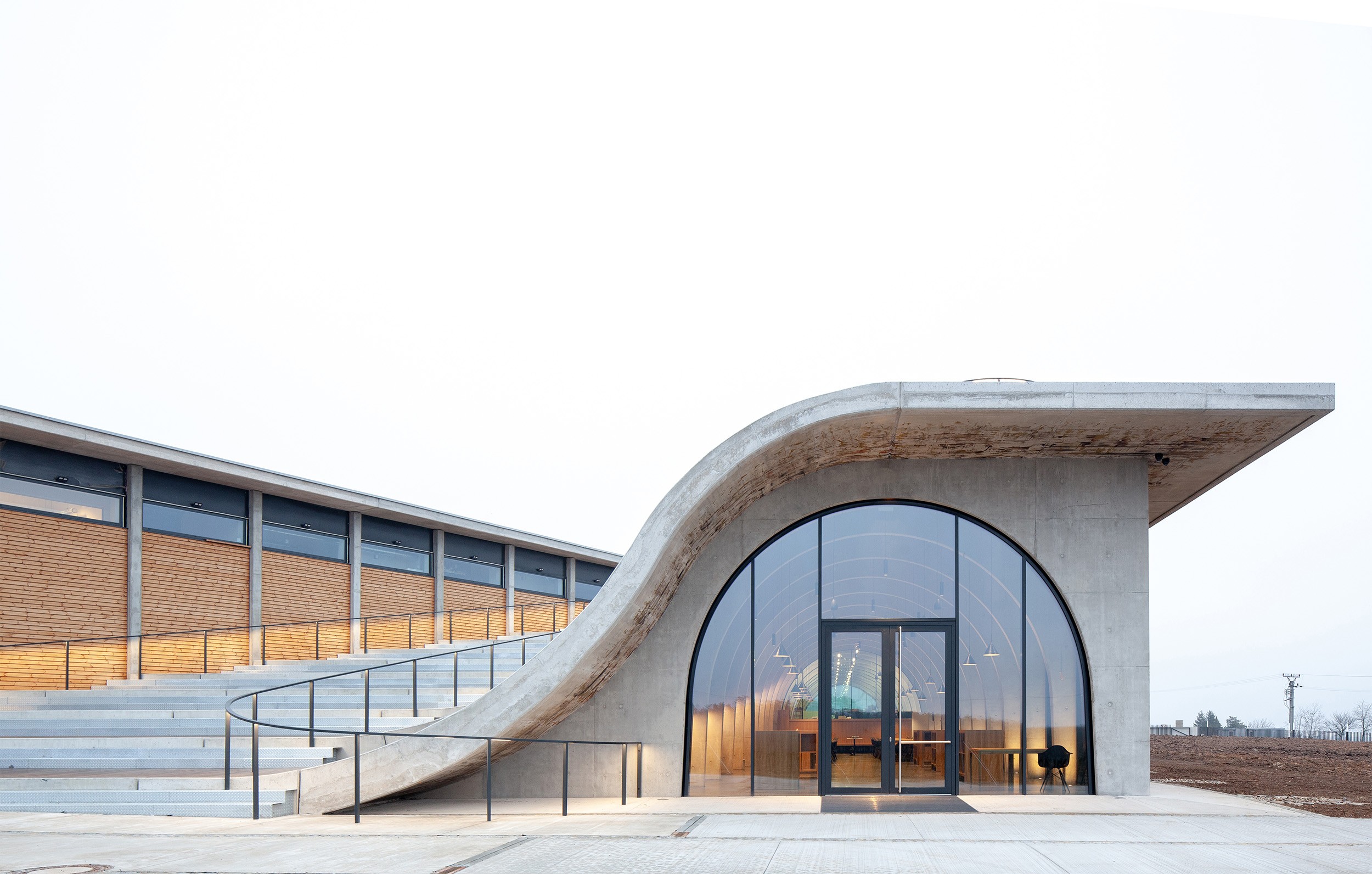

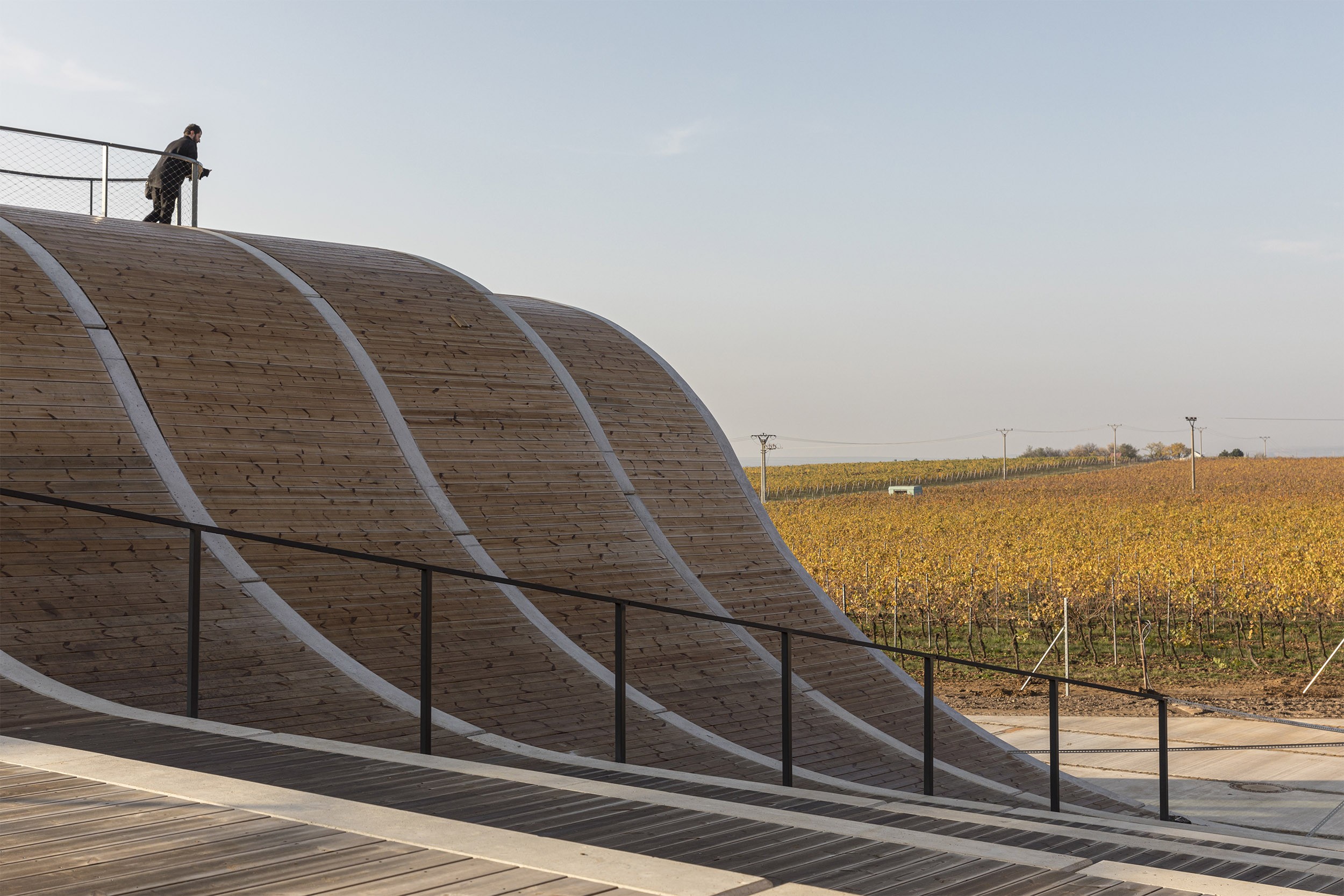
在凹凸不平的“波浪”之中,有两个高度不同的大厅包含了两个不同的操作空间。第一个较低的大厅集中包括酿酒生产和员工设施的空间,而第二个大厅温度较低,适合进行葡萄酒压榨机、酒窖和葡萄酒商店等空间。不同高度的室内空间顺应了室外的地形,允许相应功能的外部庭院对齐。一个庭院作为操作区域,集中物流和生产设备,另一个庭院作为露天剧场,延伸景观视野。
In the continuity of this material wave, the structure houses its production in two halls of distinct heights, each mirroring a specific process. The first lower hall centralizes the operations, including wine-making production and employee facilities, while the second allows for operations that require lower temperatures, such as the wine press, the cellar, and the wine store. The varying heights of the interior spaces, emulating the terrain, allow for the alignment of corresponding functional exterior courtyards. While one courtyard serves as the operational area, centralizing logistic and production presses, the other holds the amphitheater, extending sweeping views of the landscape.
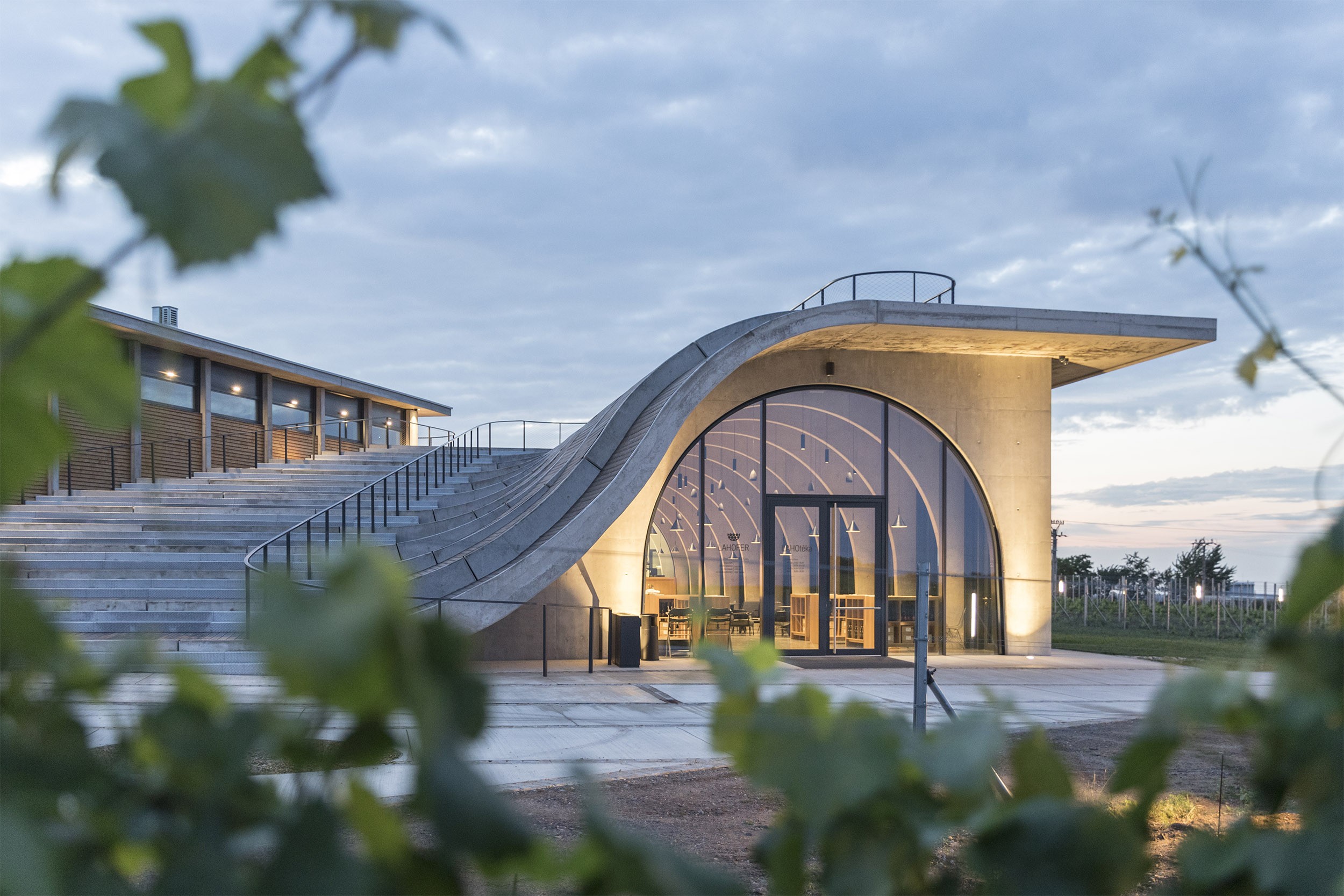
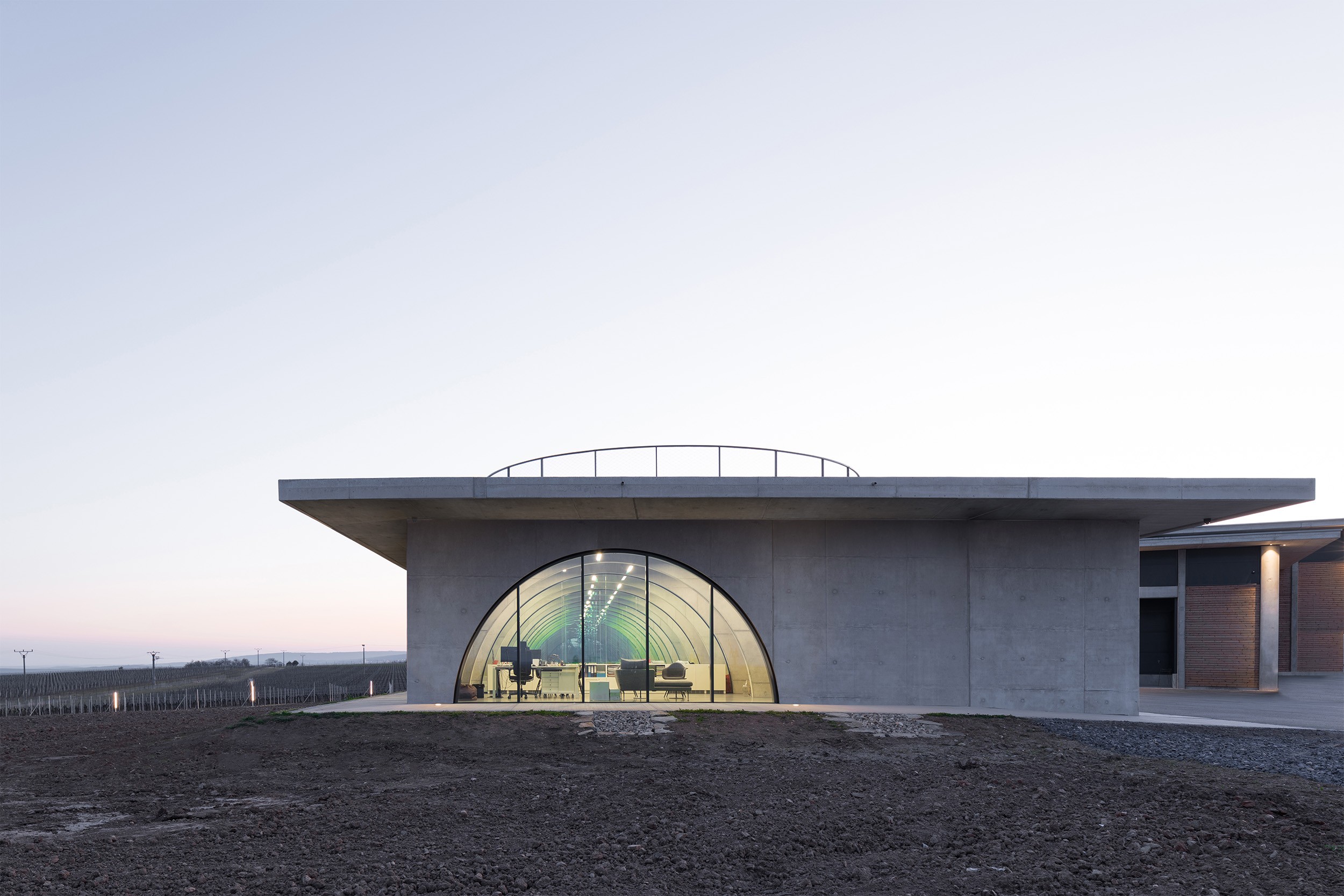


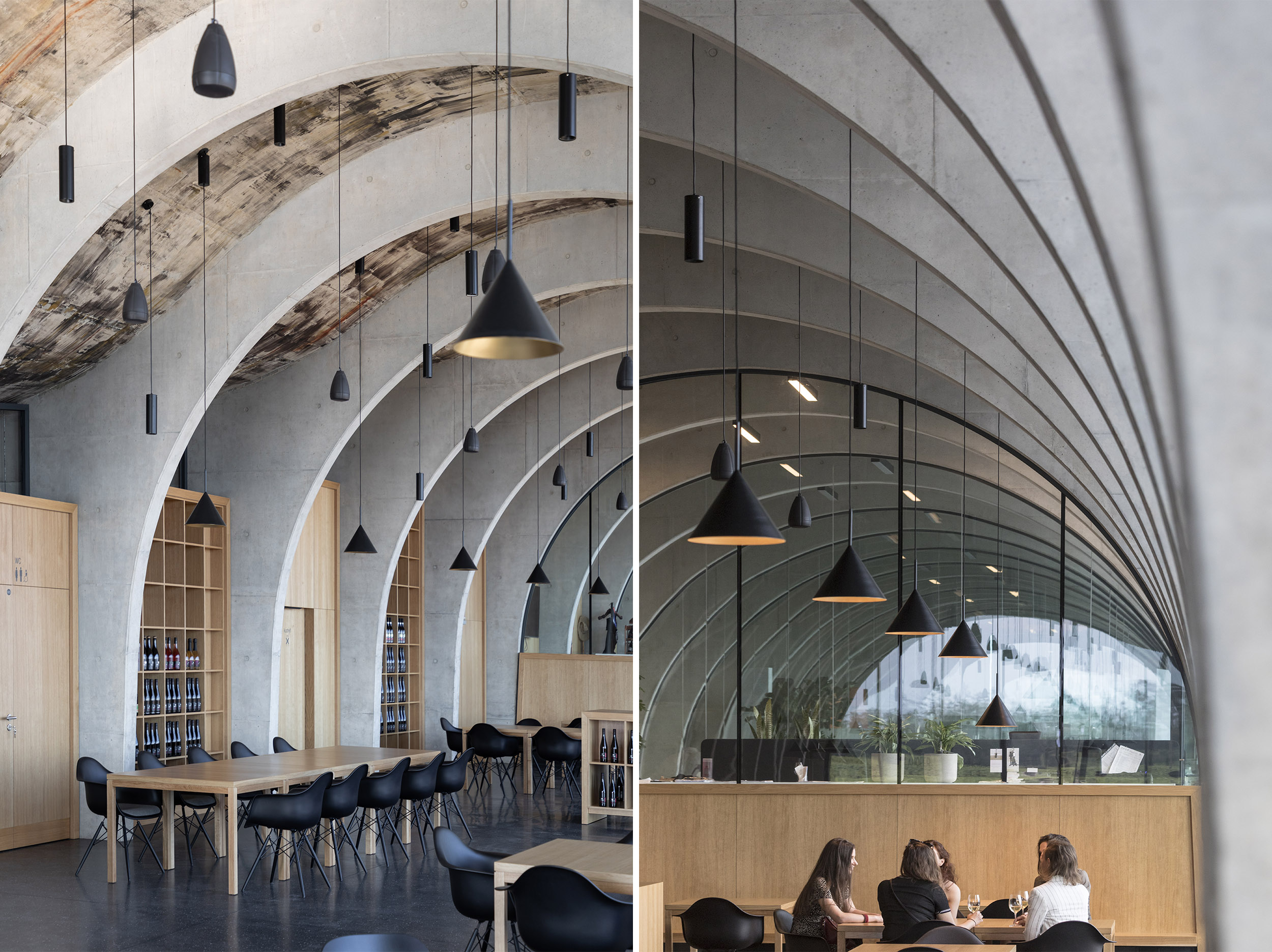


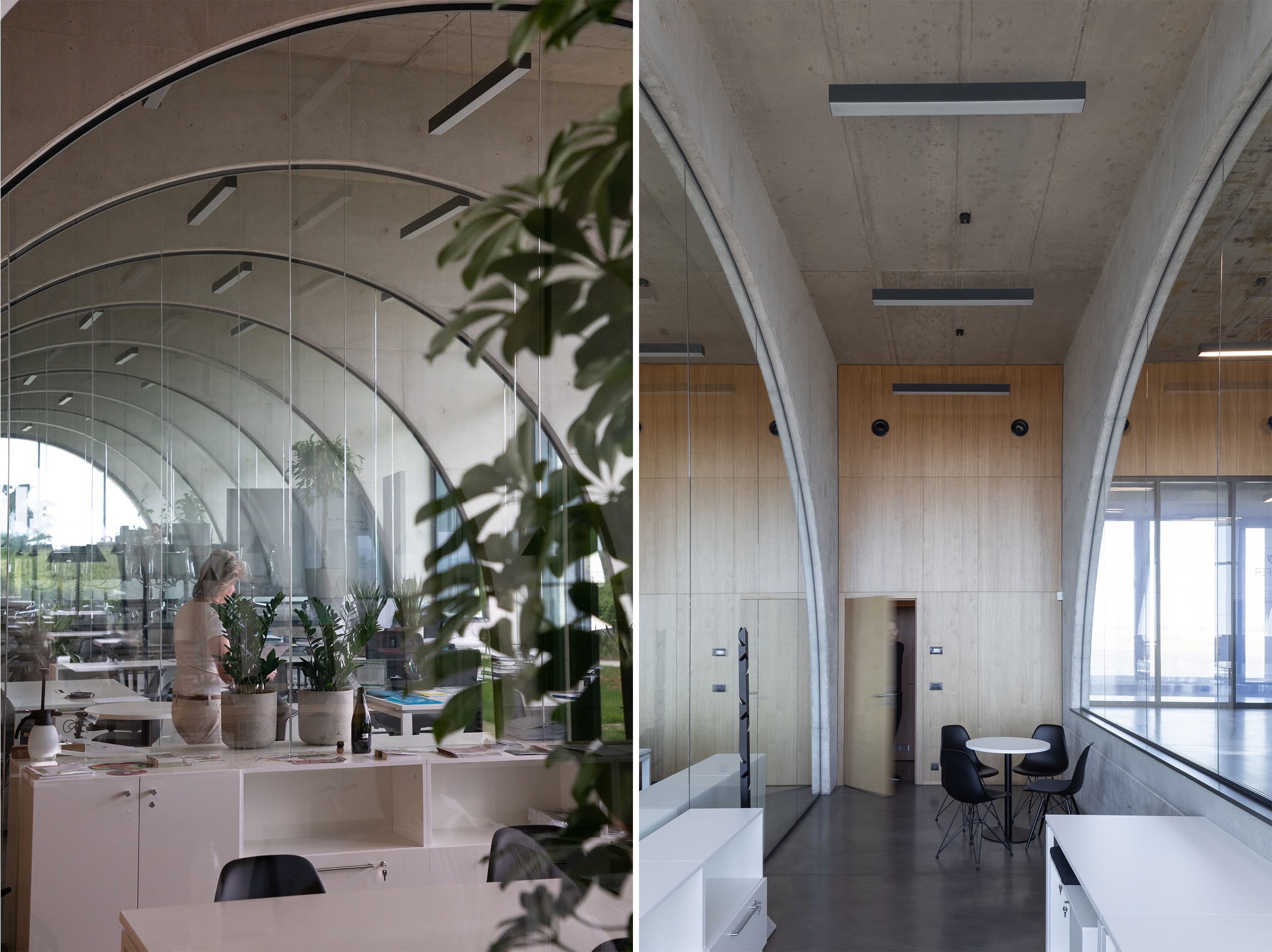
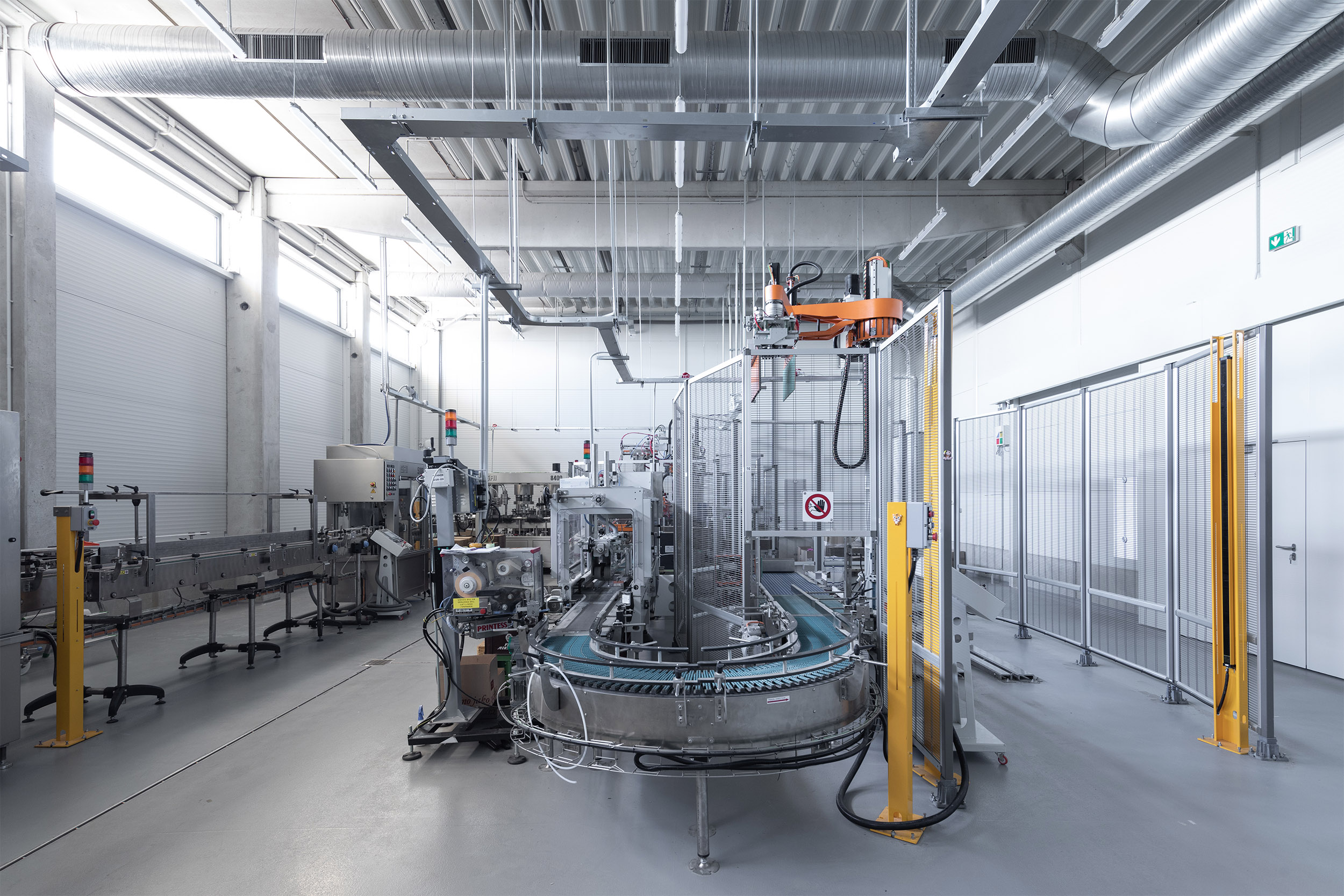
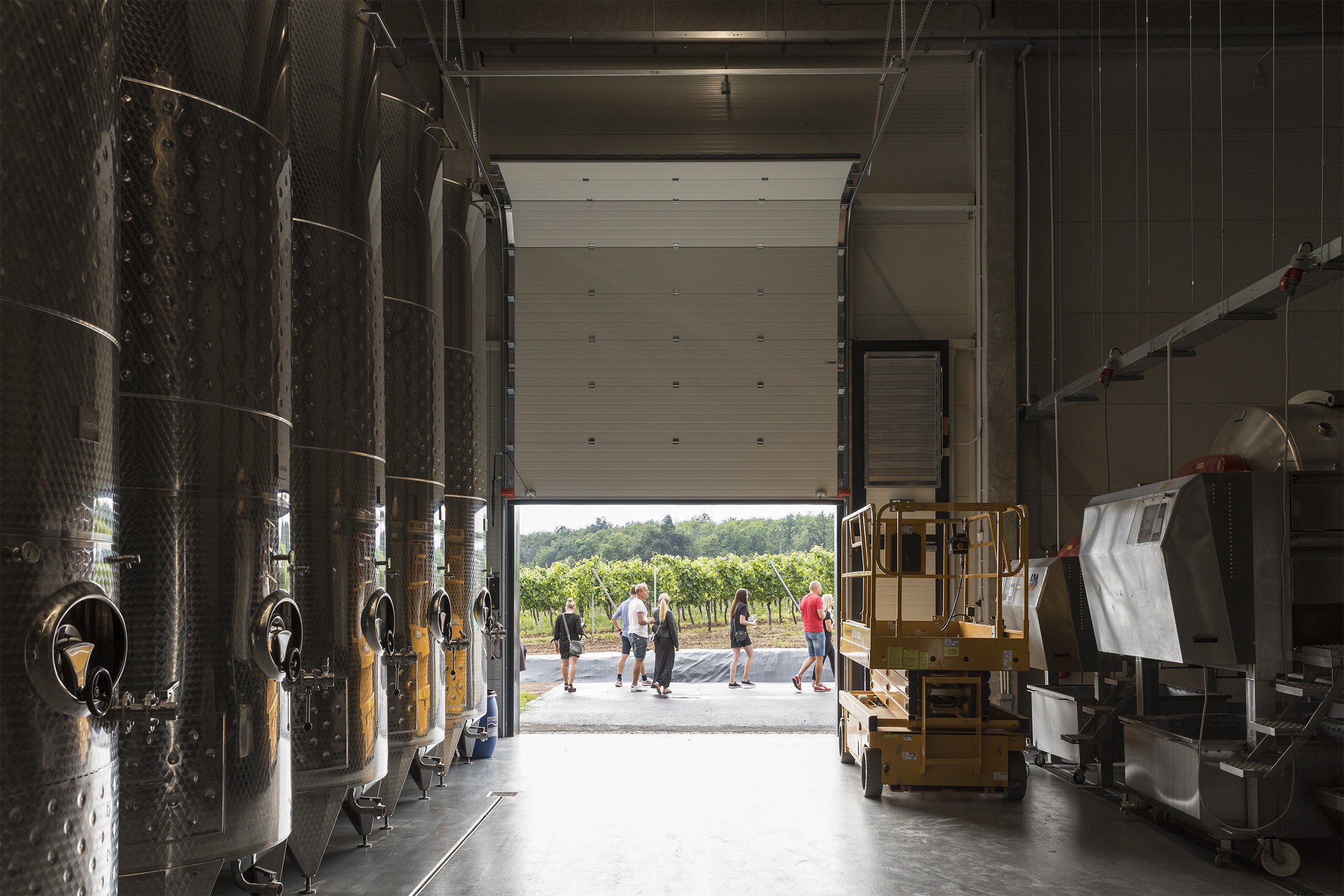
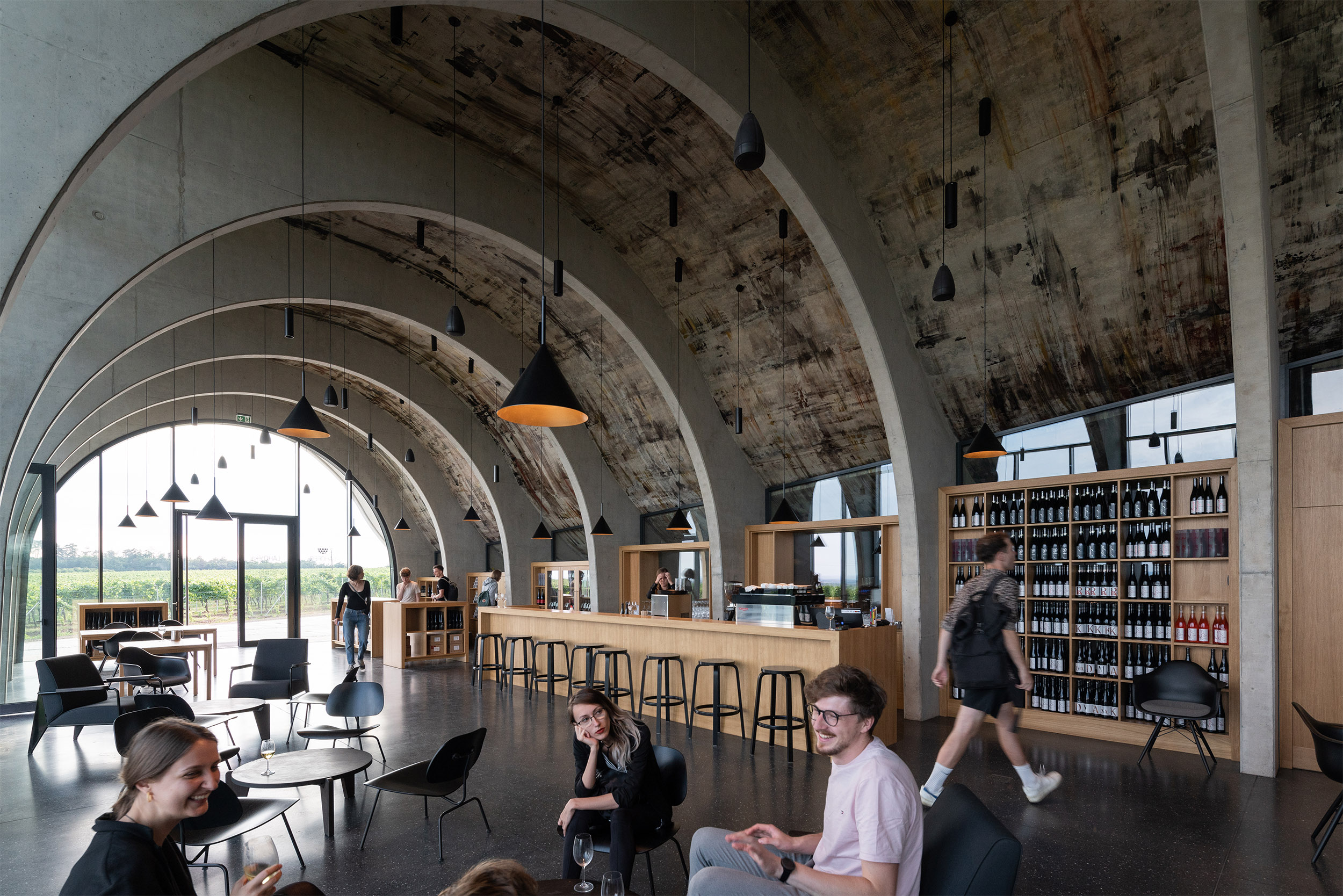
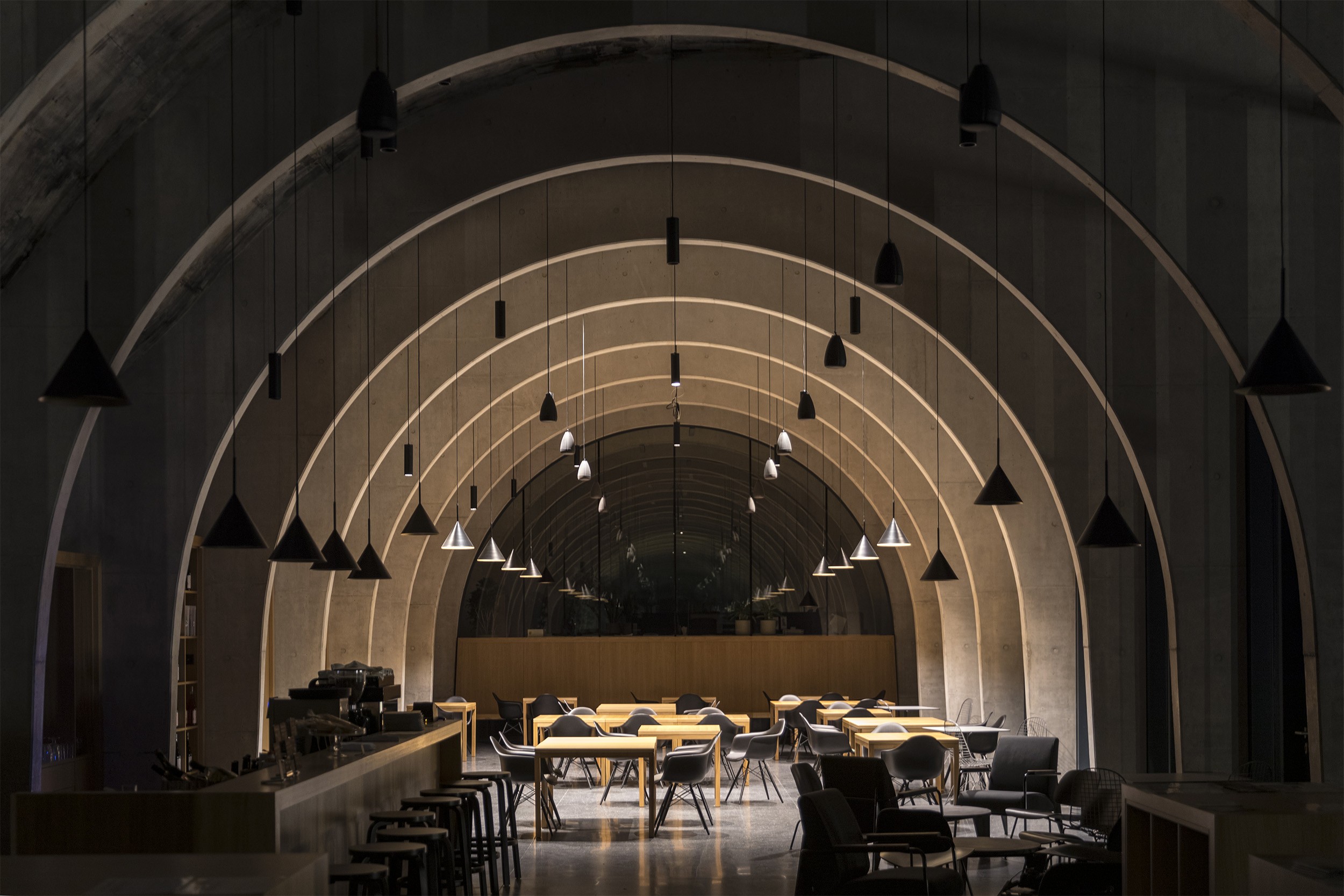
从一个开放的空间从富有韵律的藤蔓中出现,露天剧场将无边无际的屋顶点缀其中,俯瞰着被历史滋养的地平线。把Lahofer Winery酒庄的功能从生产基地扩展到了当地文化见证者,Lahofer Winery酒庄被用作专门用于文化活动的社区空间,其中包括当地的葡萄采摘庆典和戏剧演出,这是一个持久的社区中心,可以接待当地的游客和广大的葡萄酒鉴赏家。
An open space emerging from the rhythmic vines, the amphitheater invests the boundless roof, overlooking a horizon nourished by its history. Expanding on the Lahofer Winery’s function from a production site into a witness to the local culture, it acts as a community space dedicated to cultural events, including local grape harvest celebrations and theater performances – a hub for its lasting community to connect with visitors of the region and wide-ranging wine connoisseurs.
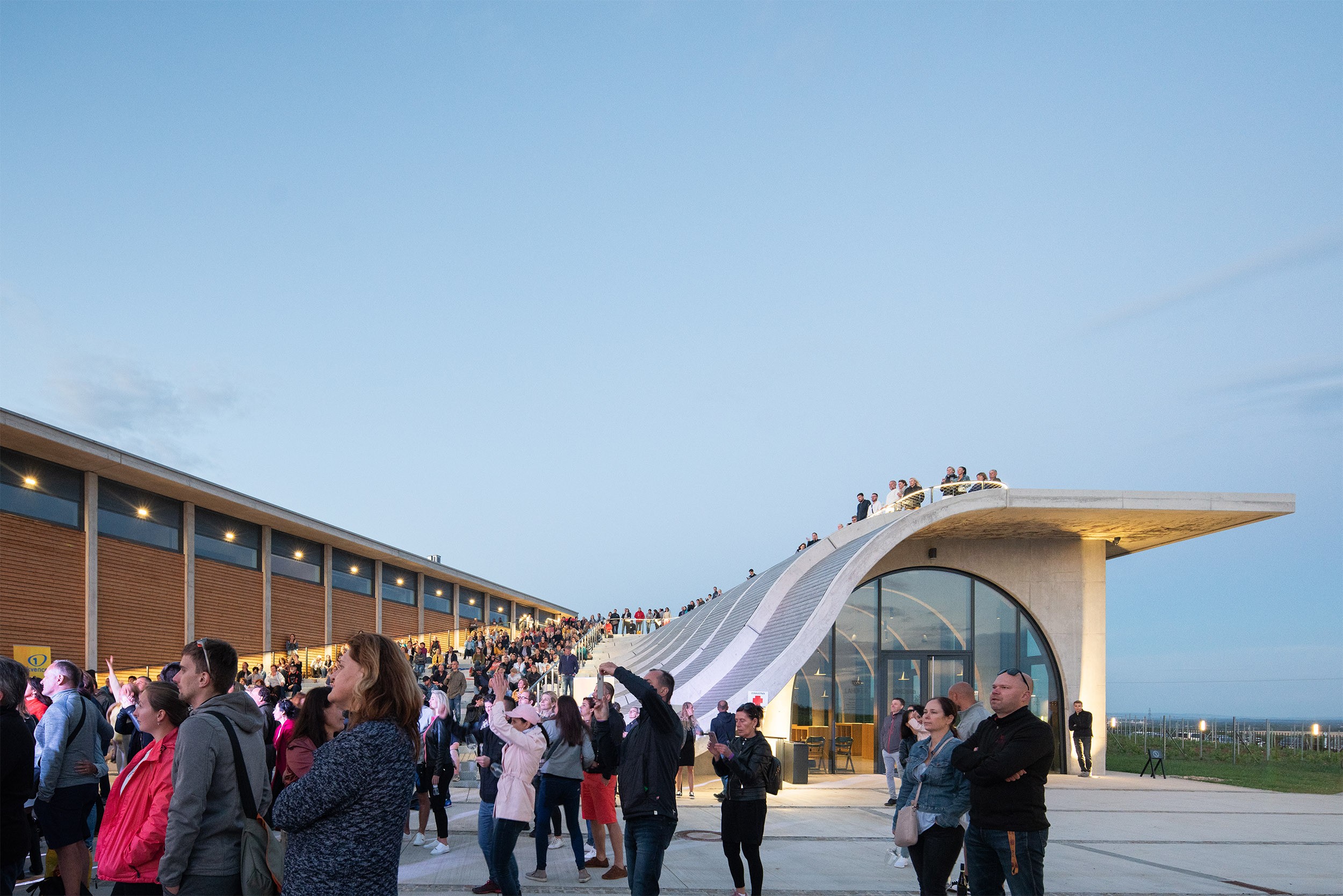
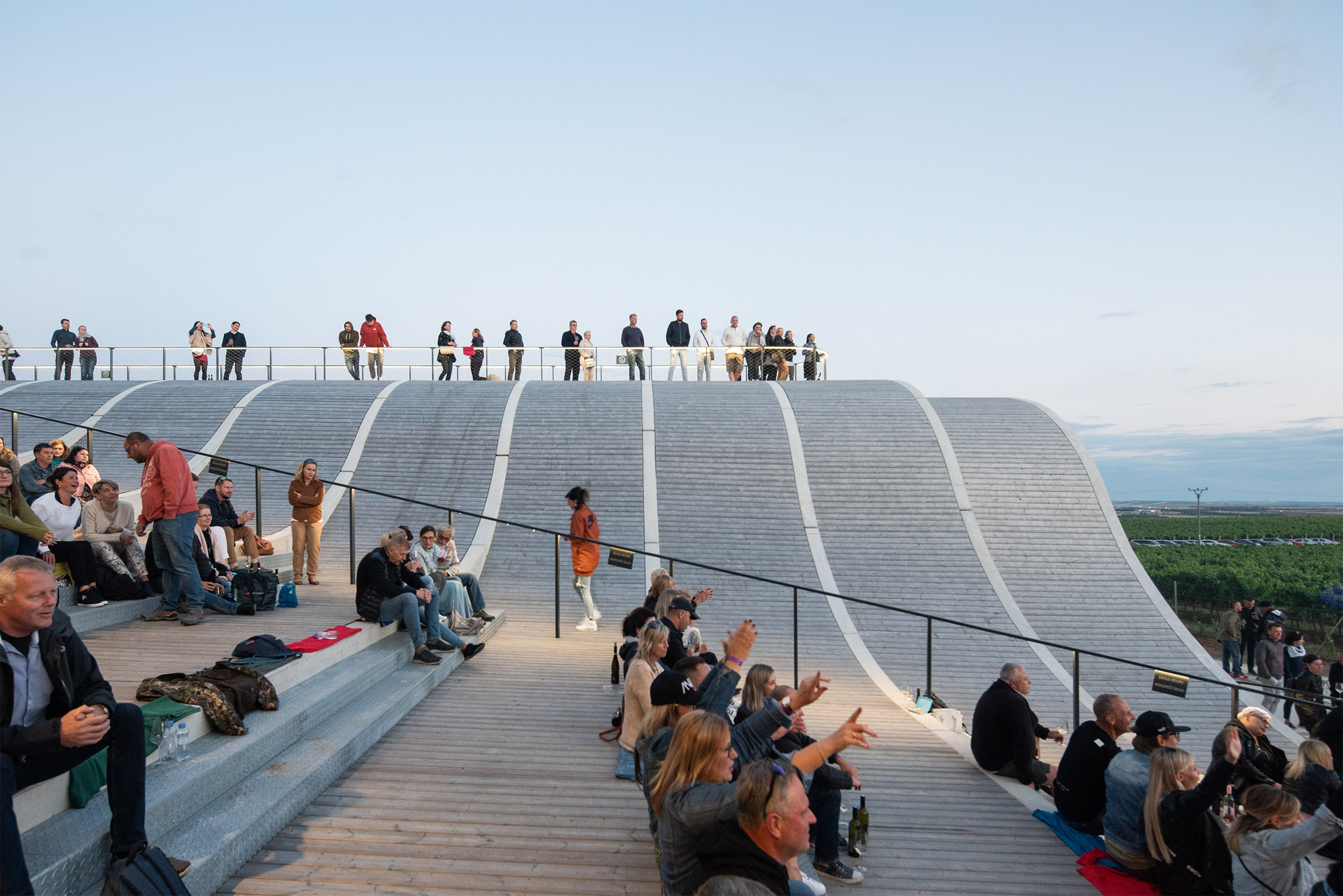


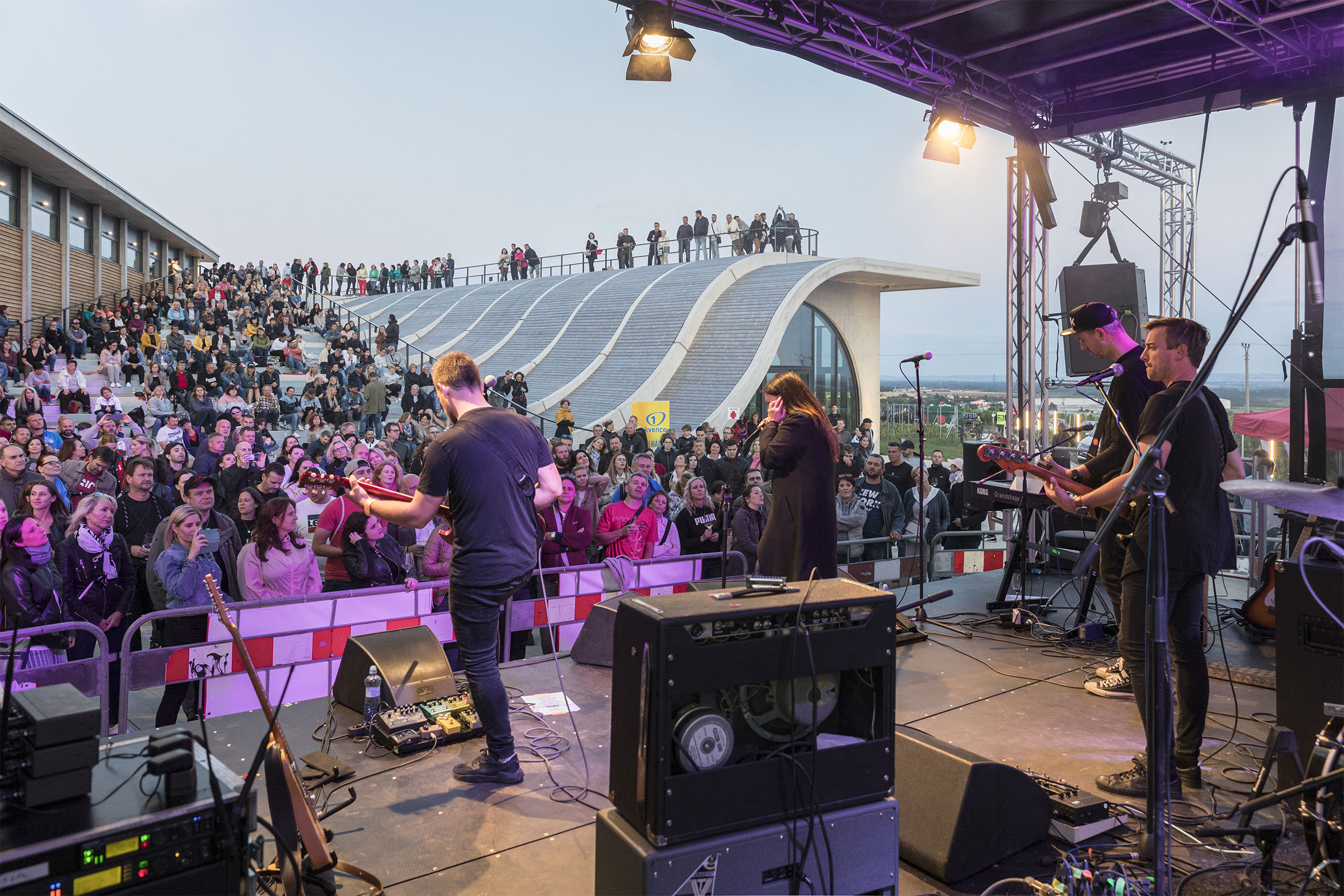
创始建筑师Ondřej Chybík和Michal Krištof在描述这个概念时解释说:"Lahofer酒庄的设计深深植根于自然,并尊重自然。当文化和自然似乎是对立的力量时,我们设想了一个反映该地区两者之间长期共生的空间--一个深刻地尊重其所在环境的空间。建筑物在原生地形中展开,沉浸在周围的葡萄树丛中,从而保留了土壤和文化的本质和完整性。此外,超越了纯粹的生产视角,我们优先考虑游客的体验,特别是将屋顶分配为公共空间,向本地和国际游客开放--这种体验对理解和欣赏葡萄酒至关重要。"
Describing the concept, founding architects Ondřej Chybík and Michal Krištof explain, “The design of the Lahofer Winery is deeply rooted in nature, and in the respect thereof. At a time when culture and nature appear to be antagonistic forces, we envision a space reflective of the longstanding symbiosis between the two in the region – one that profoundly respects the environment on which it rests. The structure unfolds into the native terrain, immerses itself into the surrounding vine rows, thereby preserving the essence and integrity of both soil and culture. Additionally, moving beyond a purely productive viewpoint, we prioritize the visitor experience, notably by allocating the roof as a public space open to local and international visitors – an experience essential to the understanding and appreciation of the wine.”


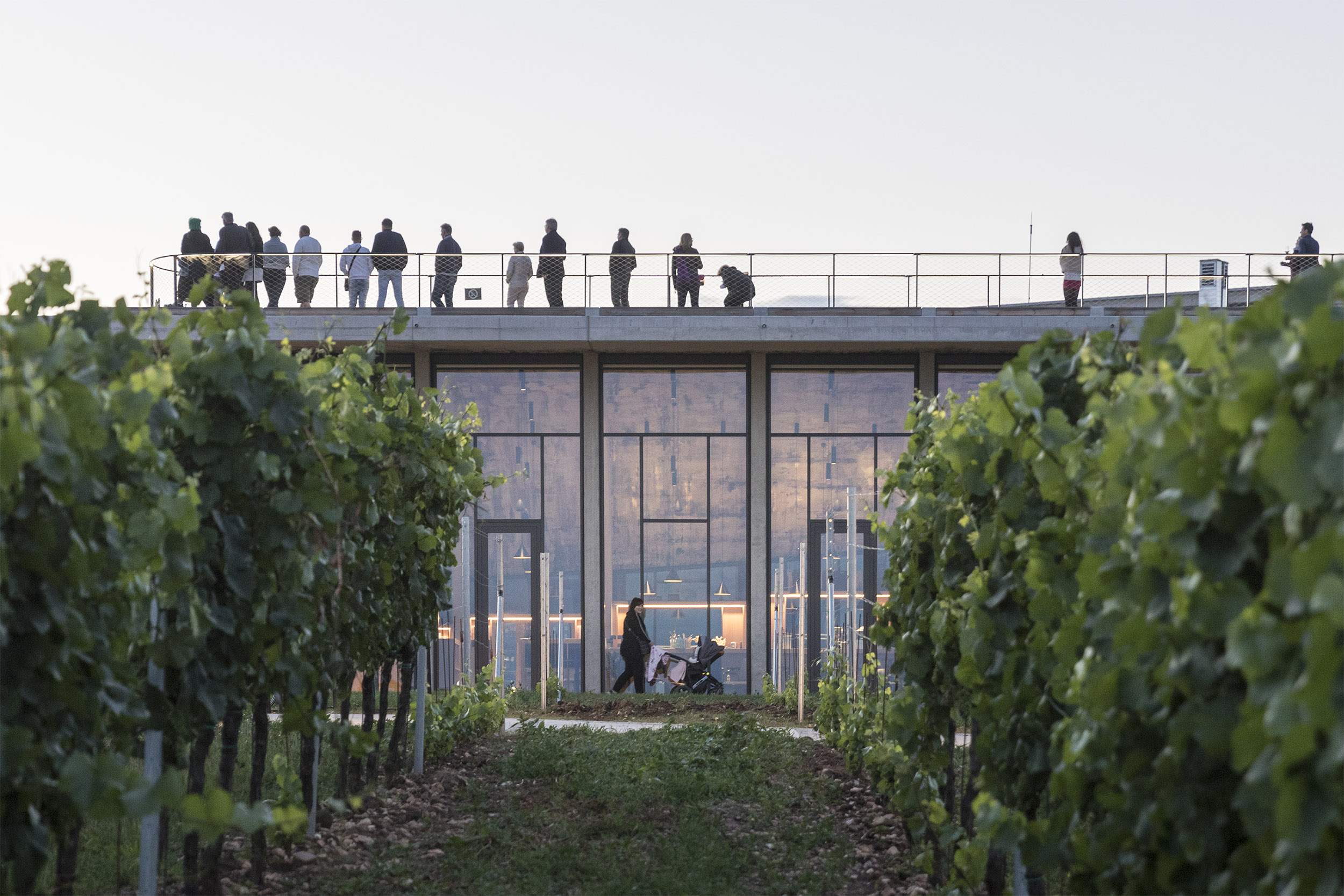

项目名称:Lahofer Winery
设计单位:CHYBIK + KRISTOF ARCHITECTS & URBAN DESIGNERS
项目客户:Lahofer Winery
项目地点:捷克共和国 Dobšice
竣工时间:2020年春季
项目面积:3,900平方米
项目团队:Ondrej Chybik,Michal Kristof,Hanin Al-Gibury,Karolina Holankova,Martin Holy,Vojtech Kouril,Ondrej Mundl,Matej Strba,Zuzana Zathurecka,Zuzana Pelikanova,Victor Cojocaru,Laura EmilijaDruktenietň,ZuzanaLááá
图片来源:Alex Shoots Buildings, Laurian Ghinitoiu
Project Name: Lahofer Winery
Architect: CHYBIK + KRISTOF ARCHITECTS & URBAN DESIGNERS
Client: Lahofer Winery
Location: Dobšice, Czech Republic
Year: 2015
Completion: Spring 2020
Size: 3 900 m2 (Ground floor area)
Status: Building Site
Team: Ondrej Chybik, Michal Kristof, Hanin Al-Gibury, Karolina Holankova, Martin Holy, Vojtech Kouril, Ondrej Mundl, Matej Strba, Zuzana Zathurecka, Zuzana Pelikanova, Victor Cojocaru, Laura Emilija Druktenytė, Zuzana Lisoňová, Gabriela Voláková
Photo Credit: Alex Shoots Buildings, Laurian Ghinitoiu